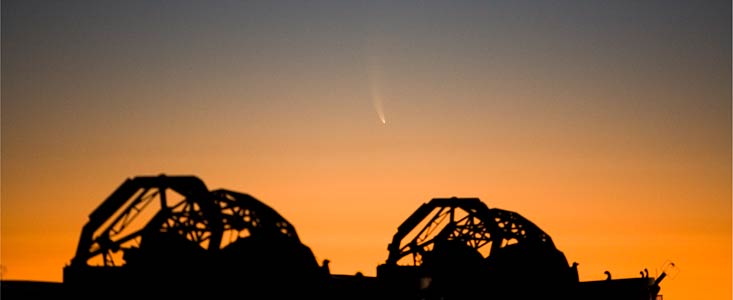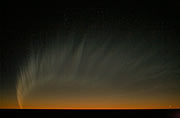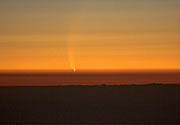Pressemitteilung
The Great Cometary Show
Comet McNaught Over Paranal
19. Januar 2007
Comet McNaught, the Great Comet of 2007, is no more visible for observers in the Northern Hemisphere. It does put an impressive show in the South, however, and observers in Chile, in particular at the Paranal Observatory, were able to capture amazing images, including a display reminiscent of an aurora!
Comet C/2006 P1 was discovered in August 2006 by Robert McNaught with the 0.5-m Uppsala Schmidt telescope in the course of the Siding Spring Survey (Australia). It is one of 29 comets discovered by this telescope since early 2004 in a project to systematically search the southern skies for asteroids, or comets, that can pass close to the Earth. At that time, the comet was only a very faint, barely diffuse object, about 50 000 times fainter than what the unaided eye can see.
However, as the comet came closer to the Sun, it brightened rapidly, in such a way as to become easily visible with the unaided eye in early January 2007, becoming brighter than Comet Hale-Bopp and Comet West, thereby earning its title of Great Comet of 2007. It even became the brightest comet in more than 40 years.
Comet McNaught had its closest approach to the Sun on 12 January, being well inside the orbit of Mercury, with a minimum distance of only 17% the mean Earth-Sun distance. On January 13, it reached its maximum brightness when it was possibly brighter than Venus.
In early January, it was visible in the northern hemisphere but after passing the Sun, it only became visible from the southern hemisphere, entering the constellation Microscopium (The Microscope) on 18 January.
Astronomers in ESO's observatories in Chile are thus optimally placed to enjoy the show and certainly do not want to miss it. The comet displays a vivid coma and a lovely, sweeping tail.
As the night deepens, and the comet had set, it revealed a sweeping fan that gives onlookers the impression they are witnessing an aurora, albeit the phenomenon is completely different. The structure in the tail is probably the fingerprint of past bursts of activity of the comet, releasing small dust particles whose paths are deflected by the solar light.
The comet is now heading further south and should still be nicely visible for southern observers for several days.
More images of the comet are available at the McNaught ESO page.
Über die Pressemitteilung
| Pressemitteilung Nr.: | eso0705 |
| Legacy ID: | PR 05/07 |
| Name: | C/2006 P1, Comet McNaught |
| Typ: | Solar System : Interplanetary Body : Comet Unspecified : Technology : Observatory : Telescope |
| Facility: | Very Large Telescope |
Our use of Cookies
We use cookies that are essential for accessing our websites and using our services. We also use cookies to analyse, measure and improve our websites’ performance, to enable content sharing via social media and to display media content hosted on third-party platforms.
ESO Cookies Policy
The European Organisation for Astronomical Research in the Southern Hemisphere (ESO) is the pre-eminent intergovernmental science and technology organisation in astronomy. It carries out an ambitious programme focused on the design, construction and operation of powerful ground-based observing facilities for astronomy.
This Cookies Policy is intended to provide clarity by outlining the cookies used on the ESO public websites, their functions, the options you have for controlling them, and the ways you can contact us for additional details.
What are cookies?
Cookies are small pieces of data stored on your device by websites you visit. They serve various purposes, such as remembering login credentials and preferences and enhance your browsing experience.
Categories of cookies we use
Essential cookies (always active): These cookies are strictly necessary for the proper functioning of our website. Without these cookies, the website cannot operate correctly, and certain services, such as logging in or accessing secure areas, may not be available; because they are essential for the website’s operation, they cannot be disabled.
Functional Cookies: These cookies enhance your browsing experience by enabling additional features and personalization, such as remembering your preferences and settings. While not strictly necessary for the website to function, they improve usability and convenience; these cookies are only placed if you provide your consent.
Analytics cookies: These cookies collect information about how visitors interact with our website, such as which pages are visited most often and how users navigate the site. This data helps us improve website performance, optimize content, and enhance the user experience; these cookies are only placed if you provide your consent. We use the following analytics cookies.
Matomo Cookies:
This website uses Matomo (formerly Piwik), an open source software which enables the statistical analysis of website visits. Matomo uses cookies (text files) which are saved on your computer and which allow us to analyze how you use our website. The website user information generated by the cookies will only be saved on the servers of our IT Department. We use this information to analyze www.eso.org visits and to prepare reports on website activities. These data will not be disclosed to third parties.
On behalf of ESO, Matomo will use this information for the purpose of evaluating your use of the website, compiling reports on website activity and providing other services relating to website activity and internet usage.
Matomo cookies settings:
Additional Third-party cookies on ESO websites: some of our pages display content from external providers, e.g. YouTube.
Such third-party services are outside of ESO control and may, at any time, change their terms of service, use of cookies, etc.
YouTube: Some videos on the ESO website are embedded from ESO’s official YouTube channel. We have enabled YouTube’s privacy-enhanced mode, meaning that no cookies are set unless the user actively clicks on the video to play it. Additionally, in this mode, YouTube does not store any personally identifiable cookie data for embedded video playbacks. For more details, please refer to YouTube’s embedding videos information page.
Cookies can also be classified based on the following elements.
Regarding the domain, there are:
- First-party cookies, set by the website you are currently visiting. They are stored by the same domain that you are browsing and are used to enhance your experience on that site;
- Third-party cookies, set by a domain other than the one you are currently visiting.
As for their duration, cookies can be:
- Browser-session cookies, which are deleted when the user closes the browser;
- Stored cookies, which stay on the user's device for a predetermined period of time.
How to manage cookies
Cookie settings: You can modify your cookie choices for the ESO webpages at any time by clicking on the link Cookie settings at the bottom of any page.
In your browser: If you wish to delete cookies or instruct your browser to delete or block cookies by default, please visit the help pages of your browser:
Please be aware that if you delete or decline cookies, certain functionalities of our website may be not be available and your browsing experience may be affected.
You can set most browsers to prevent any cookies being placed on your device, but you may then have to manually adjust some preferences every time you visit a site/page. And some services and functionalities may not work properly at all (e.g. profile logging-in, shop check out).
Updates to the ESO Cookies Policy
The ESO Cookies Policy may be subject to future updates, which will be made available on this page.
Additional information
For any queries related to cookies, please contact: pdprATesoDOTorg.
As ESO public webpages are managed by our Department of Communication, your questions will be dealt with the support of the said Department.







